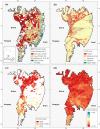Changes in land use enhance the sensitivity of tropical ecosystems to fire-climate extremes
- PMID: 35046481
- PMCID: PMC8770517
- DOI: 10.1038/s41598-022-05130-0
Changes in land use enhance the sensitivity of tropical ecosystems to fire-climate extremes
Abstract
The Pantanal, the largest contiguous wetland in the world with a high diversity of ecosystems and habitat for several endangered species, was impacted by record-breaking wildfires in 2020. In this study, we integrate satellite and modeling data that enable exploration of natural and human contributing factors to the unprecedented 2020 fires. We demonstrate that the fires were fueled by an exceptional multi-year drought, but dry conditions solely could not explain the spatial patterns of burning. Our analysis reveals how human-caused fires exacerbated drought effects on natural ecosystem within the Pantanal, with large burned fractions primarily over natural (52%), and low cattle density areas (44%) in 2020. The post-fire ecosystem and hydrology changes also had strong ecological effects, with vegetation productivity less than - 1.5 σ over more than 30% of the natural and conservation areas. In contrast to more managed areas, there was a clear decrease in evaporation (by ~ 9%) and an increase in runoff (by ~ 5%) over the natural areas, with long-term impacts on ecosystem recovery and fire risk. This study provides the first tropical evidence outside rainforests of the synergy between climate, land management and fires, and the associated impacts on the ecosystem and hydrology over the largest contiguous wetlands in the world.
© 2022. The Author(s).
Conflict of interest statement
The authors declare no competing interests.
Figures



References
-
- Hardesty J, Myers R, Fulks W. Fire, ecosystems, and people: a preliminary assessment of fire as a global conservation issue. George Wright Forum. 2005;22:78–87.
-
- Bodí MB, et al. Wildland fire ash: production, composition and eco-hydro-geomorphic effects. Earth-Sci. Rev. 2014;130:103–127. doi: 10.1016/j.earscirev.2013.12.007. - DOI
-
- Knicker H. How does fire affect the nature and stability of soil organic nitrogen and carbon? a review. Biogeochemistry. 2007;85:91–118. doi: 10.1007/s10533-007-9104-4. - DOI
Publication types
LinkOut - more resources
Full Text Sources

